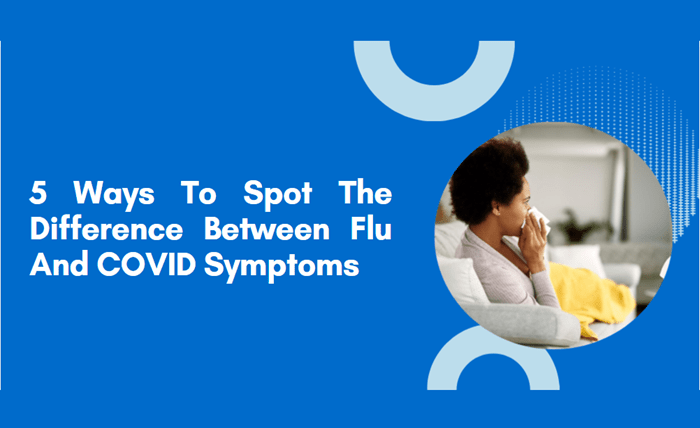
When you start to feel sick, it can be hard to tell what’s going on. Is it the flu, or is it COVID-19?
Both illnesses can cause fatigue, aches, and fever, leaving you uncertain about what you’re dealing with. The symptoms often overlap, and in the first few days, they may feel almost identical. You might wake up with a sore throat, a cough, or chills and wonder which one it is.
This confusion is common, especially during flu season or when COVID cases rise.
Knowing how to distinguish between them is important because it helps you receive the right care at the right time and keeps others safe from contracting the illness. Understanding the difference between the flu and COVID can also ease your mind and help you take quick, smart steps toward recovery.
Below are five simple ways to recognize the difference between these two illnesses.
1. Notice How Fast the Illness Starts
The speed at which you get sick can reveal a lot and is one of the first signs to notice when trying to understand the difference between the flu and COVID. The flu often strikes quickly and severely, taking you by surprise. One moment you feel fine, and the next, you’re suddenly exhausted, with fever, body aches, and chills setting in almost out of nowhere. The change can be so sudden that many people recall the exact hour they first started feeling sick.
COVID-19, on the other hand, tends to move at a slower pace. It often begins with mild symptoms, such as a sore throat, a light cough, or slight fatigue. Over the next few days, these signs can gradually worsen, making it harder to pinpoint when the illness began. This gradual onset is a key clue that it may be COVID rather than the flu.
Also, the flu’s sudden arrival often leaves you feeling completely drained right away, while COVID can creep up quietly. Paying close attention to how quickly your symptoms appear and progress can help you recognize the difference early and seek the right care before your condition worsens.

2. Pay Attention to Type of Symptoms You Feel
When trying to distinguish between the flu and COVID, paying attention to the type of symptoms you experience can help clarify the difference. Both illnesses share several common signs, but certain details distinguish them once you know what to look for.
The flu usually brings a high fever, chills, sore muscles, and deep tiredness that comes on quickly. You may also have a headache and a dry cough that makes your throat feel rough. As the illness takes hold, many people describe feeling as if they’ve been hit by a truck because of the sudden, full-body ache and fatigue.
In contrast, COVID-19 symptoms can vary much more from person to person. You might have a fever and cough, but others could lose their sense of taste or smell altogether. That loss is a unique sign of COVID and rarely happens with the flu. Some people also notice shortness of breath, chest tightness, or lingering tiredness even after the worst part of the illness has passed.
3. Check How Long Do the Symptoms Last
The duration of your illness can also help you distinguish between the flu and COVID.
Flu symptoms typically subside after about a week. Most people start to feel better once the fever breaks and the body aches fade. You may still feel weak for a few more days, but recovery is usually quick.
COVID can linger. Some people feel sick for two weeks or more. In some cases, symptoms hang on for much longer. Many people describe feeling tired, weak, or out of breath even after the main infection is gone. This condition is often referred to as “long COVID,” and it can take weeks or months to recover fully.
If you find your cough, fatigue, or shortness of breath keeps dragging on, COVID may be the reason. The flu rarely causes symptoms that last this long.

4. Know How Each Illness Spreads
Both the flu and COVID-19 spread in similar ways, primarily through tiny droplets in the air when a person with the illness coughs or sneezes. You can also become infected by touching a surface contaminated with the virus and then touching your mouth, nose, or eyes.
The key difference lies in the contagiousness of each illness. COVID spreads more easily than the flu. You can catch it even when someone doesn’t look or feel very sick. Some people with COVID never show symptoms at all, but they can still spread it.
Flu symptoms tend to appear faster, so most people know when they’re sick and stay home. COVID’s delayed or mild early signs make it easier to spread without realizing it.

5. Know How to Confirm What You Have
Since the symptoms of both illnesses can look so similar, it’s often hard to tell on your own whether it’s the flu or COVID. The most reliable way to confirm is through testing. Rapid tests for both are quick, easy, and available at most healthcare centers.
Getting tested helps you identify the illness early, start the right treatment, and prevent the spread it to others. If the test indicates that you have the flu, rest, drink plenty of fluids, and take antiviral medication as prescribed by your doctor. Most people begin to recover within a few days.
However, if your test confirms COVID, your healthcare provider may suggest different treatments based on your symptoms and overall health. Testing brings clarity and helps you recover more quickly.
Final Thoughts
Flu and COVID-19 can make you feel miserable, but they are distinct illnesses. The flu tends to strike fast, with fever and body aches that appear suddenly. COVID develops more slowly, can cause a loss of taste or smell, and often lasts longer.
If you ever feel unsure about what you’re dealing with, don’t try to figure it out alone. Visit a trusted healthcare provider for testing and care.




